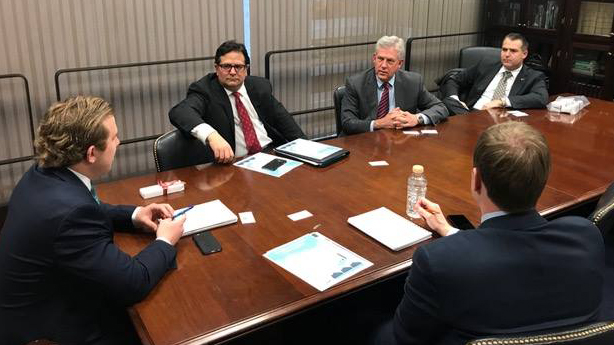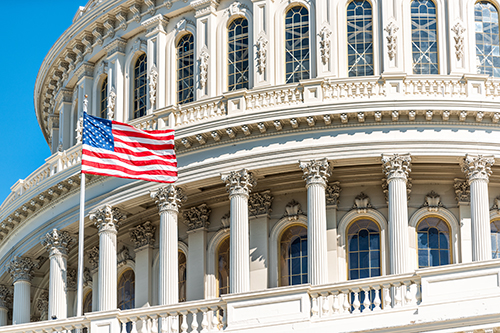Harvey Update: Judge Doyal and Other Local Leaders Continue to Provide Relief; Mitigate Future Flooding
 Hurricane Harvey unleashed torrential rainfall – greater than 60 inches in some places – killing 88 people and displacing 30,000. Slamming ashore about six months ago, Harvey caused an estimated $198 billion in damages, making it the costliest hurricane in United States history.
Hurricane Harvey unleashed torrential rainfall – greater than 60 inches in some places – killing 88 people and displacing 30,000. Slamming ashore about six months ago, Harvey caused an estimated $198 billion in damages, making it the costliest hurricane in United States history.
Montgomery County Sheriff’s Lt. Scott Spencer says locally there were “more than 1300 high water rescues performed, approximately 1100 citizens [had to be sheltered], roughly 300 roads were impassable, and many homes and businesses sustained water damaged or [were] destroyed.” The Woodlands Township Board Chairman Gordy Bunch, speaking at the recent Economic Outlook Conference hosted by The Woodlands Chamber of Commerce, said The Woodlands Fire Department responded exceptionally and more than 10,000 civilian volunteers turned out to help.
During tragic events like this, it is critical that people can depend on leaders in the community to help provide guidance and relief. The reality is that hurricane response doesn't just happen in the days following the storm, but in the months and years after it crashes ashore as well.
In Texas, the elected position that serves as the chief of emergency management during disasters is the county judge. Throughout Harvey and its aftermath, Montgomery County Judge Craig Doyal did his part to ensure people received local, state, and federal aid in a timely manner, demonstrating the leadership qualities he’s acquired from 17 years of service on the Montgomery County Commissioner’s Court.
As Harvey blew in, Judge Doyal acted swiftly in signing a disaster declaration for Montgomery County before flooding even began, putting Montgomery County in the front of the line for state and federal aid.
While major airports, IAH and Hobby, were shut down, Montgomery County's North Houston/Conroe airport (CXO) was the only one in the area that stayed open, serving as the base of military relief operations in our region. Thanks to the airport’s new control tower, extended runways with high weight ratings, and positioning slightly north of the storm, all the Black Hawks, Chinooks, and C-130s carrying supplies and military personnel were able to land and carry out rescue missions in the storm-ridden area.
While many county employees were excused from work because of the flooding, Judge Doyal reported for duty day and night, helping coordinate emergency relief efforts at the county’s Emergency Operations Center, holding regular news conferences, and releasing timely information to keep residents updated. He also toured flooded areas and participated in charitable efforts.
As the floodwaters began to subside, Judge Doyal was one of the first elected leaders in the Houston area to call for reappraisals on flooded properties so that flood victims would not be forced to pay property taxes based on their pre-flood valuations. Reappraisals began in September, helping to lower the tax burden for owners of Harvey-affected homes and businesses.
In January, Judge Doyal made a trip to Washington, DC with Commissioner James Noack, Township Chairman Gordy Bunch, and Township Director Bruce Rieser to meet with federal agencies, congressional staff, and Congressmen John Carter and John Culberson on the Appropriations Committee to get us the help we needed. Judge Doyal also testified before numerous legislative committees about how the State of Texas could better prepare for future flooding and work with counties to protect residents.

On February 5, Judge Doyal and James Noack met in Conroe with state and federal officials to discuss the county's vision of its disaster recovery action plan. “The information we received will help us to work with these agencies to ensure we are obtaining the funds we need for our communities,” explained Doyal.
Prior to Hurricane Harvey, Judge Doyal had already launched a joint effort with the San Jacinto River Authority, the City of Conroe, and the Texas Water Development Board to study hydrology in the area surrounding the West Fork of the San Jacinto river to create better flood-warning systems. He’s also working with the Harris County Flood Control District on an inter-local agreement to fund a comprehensive study of Montgomery County watersheds to provide better flood warnings and identify projects that could help reduce flooding in the future.
His plans include creating a reverse 911 system to inform people of rising water in certain areas via text message/amber alert, putting gauges on creeks to be able to provide early warning in flood prone areas, and working with Representative Kevin Brady in requesting federal funding to evaluate the effect that building large scale retention ponds on major tributaries in the region would have on future flooding.
Judge Doyal’s opponent in the March 6th primary elections for County Judge, Rep. Mark Keough, has offered a different plan for Montgomery County.
When Keough was asked in a recent interview what efforts he would make toward implementing flood mitigation projects or home buyout programs, he said,
“First, I would hold [the San Jacinto River Authority’s] feet to the fire and ensure they are providing their legislative mandated flood control without raising fees or taxes. Second, I would partner with stakeholders from across the county and region to look for solutions. Right now downstream capacity has been lowered due to silting and debris. Lake Houston is at 50 percent its original capacity. When Lake Houston fills up, all the water from San Jacinto River impounds upstream and floods our county. Better coordination between Lake Conroe Dam operators and the community would also be a priority. Dredging and removing debris [and sedementation] from the river and creek watersheds will also improve water flow.”
Perhaps Keough presumes dredging the lake would lower the water level and allow the lake to accommodate more water during heavy flooding.
But Lake Houston has a passive, uncontrolled spillway, meaning it cannot hold additional water for very long. Although dredging the lake may increase the lake’s capacity, passive water flow would quickly bring the lake right back to its original level. According to information from the Lake Conroe Association pertaining to Lake Houston,
"increasing the capacity [of Lake Houston] by dredging would not impact flood control if the lake level is unchanged after remediation."
Additionally, the latest regional flood protection study prepared for The City of Houston, Harris County Flood Control District, Montgomery County, and the San Jacinto River Authority in 2000 by Brown and Root Services, concluded that:
"the impact of sedementation to the flood levels and the flood plain conditions in the study area [was] considered minimal at [that] time."
Although one could speculate that sedementation has increased since that study, very recently, Jeff Lindner, meteorologist with the Harris County Flood Control District, pointed out in an interview with Community Impact news paper that:
"The flood control district did do dredging in the western part of Harris County after the Tax Day storm on creeks, and Harvey pretty much undid all of that work. So it’s expensive and you’re still at the mercy of if you do have another flood event, it can undo all of that work, so that’s why we have to kind of look at what the best solutions are for some of these problem areas."
In other words, dredging would be very expensive and have a minimal impact in mitigating flooding from heavy rainfall, so Keough’s proposal would be a wasteful and ineffective use of taxpayers’ money.
The difference in these two candiates' approaches demonstrates why it pays to have a county judge with wisdom from his experience in local government. As with any new job in the public or private sector, there is a learning curve with associated costs. When it comes to costly inefficiencies resulting from inexperience at the county level of government, local taxpayers will foot the bill.








